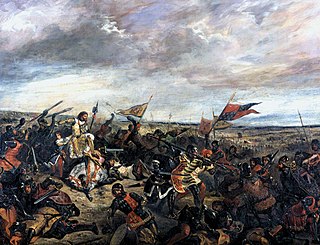
The Battle of Poitiers was a major English victory in the Hundred Years' War. It was fought on 19 September 1356 in Nouaillé, near the city of Poitiers in Aquitaine, western France. Edward, the Black Prince, led an army of English, Welsh, Breton and Gascon troops, many of them veterans of the Battle of Crécy. They were attacked by a larger French force led by King John II of France, which included allied Scottish forces. The French were heavily defeated; an English counter-attack captured King John, along with his youngest son, and much of the French nobility who were present.
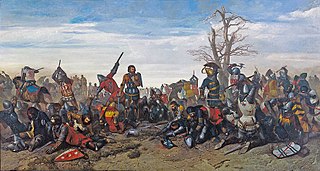
The Combat of the Thirty, occurring on 26 March 1351, was an episode in the Breton War of Succession fought to determine who would rule the Duchy of Brittany. It was an arranged fight between selected combatants from both sides of the conflict, fought at a site midway between the Breton castles of Josselin and Ploërmel among 30 champions, knights, and squires on each side. The challenge was issued by Jean de Beaumanoir, a captain of Charles of Blois supported by King Philip VI of France, to Robert Bemborough, a captain of Jean de Montfort supported by Edward III of England.

John II reigned as Duke of Brittany from 1286 until his death, and was also Earl of Richmond in the Peerage of England. He took part in two crusades prior to his accession to the ducal throne. As a duke, John was involved in the conflicts between the kings of France and England. He was crushed to death in an accident during the celebrations of a papal coronation.
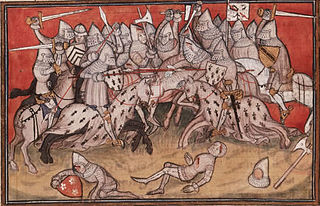
The War of the Breton Succession was a conflict between the Counts of Blois and the Montforts of Brittany for control of the Sovereign Duchy of Brittany, then a fief of the Kingdom of France. It was fought between 1341 and 12 April 1365.
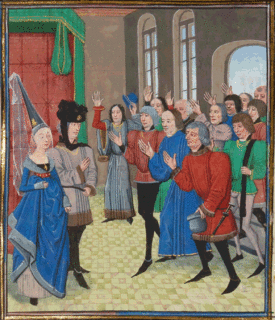
John of Montfort, sometimes known as John IV of Brittany, and 6th Earl of Richmond from 1341 to his death. He was the son of Arthur II, Duke of Brittany and his second wife, Yolande de Dreux. He contested the inheritance of the Duchy of Brittany by his niece, Joan of Penthièvre, which led to the War of the Breton Succession, which in turn evolved into being part of the Hundred Years' War between England and France. John's patron in his quest was King Edward III of England. He died in 1345, 19 years before the end of the war, and the victory of his son John IV over Joan of Penthièvre and her husband, Charles of Blois.

Charles of Blois-Châtillon "the Saint", was the legalist Duke of Brittany from 1341 to his death via his marriage to Joan of Penthiève, holding the title against the claims of John of Montfort. The cause of his possible canonization was the subject of a good deal political maneuvering on the part of his cousin, Charles V of France who endorsed it, and his rival, Montfort, who opposed it. The cause fell dormant after Pope Gregory XI left Avignon in 1376, but was revived in 1894. Charles of Blois was beatified in 1904.

Sir John Chandos, Viscount of Saint-Sauveur in the Cotentin, Constable of Aquitaine, Seneschal of Poitou, was a medieval English knight who hailed from Radbourne Hall, Derbyshire. Chandos was a close friend of Edward the Black Prince and a founding member and 19th Knight of the Order of the Garter in 1348. Chandos was a gentleman by birth, but unlike most commanders of the day he held no inherited title of nobility.

Josselin is a commune in the Morbihan department in Brittany in north-western France.

Ploërmel is a commune in the Morbihan department in Brittany in north-western France. On 1 January 2019, the former commune Monterrein was merged into Ploërmel.

Joanna of Flanders was Duchess of Brittany by her marriage to John of Montfort. Much of her life was taken up in defence of the rights of her husband and, later, son to the dukedom, which was challenged by the House of Blois during the War of the Breton Succession. Known for her fiery personality, Joanna led the Montfortist cause after her husband had been captured, and began the fight-back, showing considerable skill as a military leader.

The first phase of the Hundred Years' War between France and England lasted from 1337 to 1360. It is sometimes referred to as the Edwardian War because it was initiated by King Edward III of England, who claimed the French throne in defiance of King Philip VI of France. The dynastic conflict was caused by disputes over the French feudal sovereignty over Aquitaine and the English claims over the French royal title. The Kingdom of England and its allies dominated this phase of the war.

Olivier Le Vieux de Clisson, dit Olivier V de Clisson, nicknamed "The Butcher", was a Breton soldier, the son of Olivier IV de Clisson. His father had been put to death by the French in 1343 on the suspicion of having willingly given up the city of Vannes to the English.
The Battle of Saint-Pol-de-Léon was a minor action during the Breton War of Succession and thus part of the larger Hundred Years War. The battle was fought in June 1346 and marked a minor turning point in the fortunes of the Montfortists and their English allies in Brittany following several setbacks including the imprisonment and subsequent death of their leader, John of Montfort.
The Battle of Mauron was fought in 1352 between an Anglo-Breton force and France. The Anglo-Bretons were victorious. The battle took place in the context of the Hundred Years War. With the Franco-Breton claimant, Charles de Blois, a prisoner, and the Anglo-Breton claimant a minor, the English were attempting to rule Brittany in the name of their protégé.
Jean, or Jehan de Beaumanoir, marshal of Brittany for Charles of Blois, and captain of Josselin, is remembered for his share in the famous Combat of the Thirty during the War of Breton Succession (1341–1364) between the partisans of competing claimants for the Dukedom.
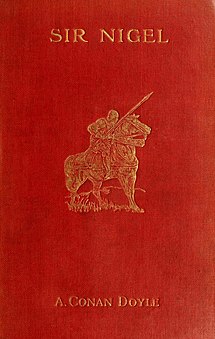
Sir Nigel is a historical novel set during the early phase of the Hundred Years' War, spanning the years 1350 to 1356, by British author Sir Arthur Conan Doyle first published in serial form during 1905–06. It is the background story to Doyle's earlier novel The White Company (1891), and describes the early life of that book's hero Nigel Loring, a knight in the service of King Edward III in the first phase of the Hundred Years' War. The character is loosely based on the historical knight Neil Loring.
The battle of Brest, sometimes called the battle of the River Penfeld, was an action in 1342 between an English squadron of converted merchant ships and that of a mercenary galley force from Genoa fighting for the Franco-Breton faction of Charles of Blois during the Breton War of Succession, a side conflict of the Hundred Years War.

Mauron is a commune in the Morbihan department and Brittany region of north-western France. It lies close to the borders of both Côtes d'Armor and Ille-et-Vilaine. Mauron's location make it a crossroads on the routes connecting Dinan to Vannes and Quimper to Rennes.
The noble Breton family line of Porhoët is represented in modern times by the Franco-Breton House of Rohan.

Josselin Castle is a medieval castle at Josselin, in the Morbihan department of Brittany, France, first built in 1008 by Guéthénoc, viscount of Porhoët. The town and castle were named after Guéthénoc's son, Goscelinus, and rebuilt at various times since. The current castle was built by Olivier de Clisson after 1370. He had acquired the land as part of the dowry on his marriage to Margaret of Rohan. It has been designated as a monument historique since 1928.















